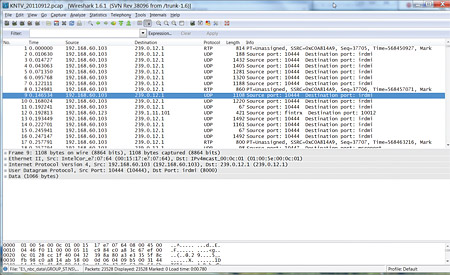This month let's take a look at two free tools I've found extremely useful for troubleshooting ATSC Mobile DTV installations: Wireshark and VLC. These two applications can be used to provide useful data on local IP-based Mobile DTV networks, although to get full functionality similar to that provided by TSReader, a commercial application such as Decontis' atscSAM or DTV Interactive's ATA-1000 is needed.

ATSC is IP-based, even though the IP packets are transported over MPEG packets. See my articles "Mobile DTV 101" and "What to Look for in A153 Mobile DTV Tables" at www.tvtechnology.com for background.
Many of the problems you are likely to encounter in a Mobile DTV setup are the same ones that cause frustration with other network equipment—conflicting IP addresses; equipment IP addresses outside the sub-net mask of the equipment it's supposed to communicate with; and bad Ethernet cables. Tracking down these problems can be difficult.
Another problem is that the video and audio streams being transmitted may be sent with the wrong encoding parameters or errors.
WIRESHARK
One of the best tools for tracking down problems on IP networks is the free program "Wireshark." It runs on many operating systems, including Windows, OS-X and Linux and analyzes network packets. Wireshark is free software.
It was started in 1997 as "Ethereal" by Gerald Combs when he needed a tool for tracking down networking problems and wanted to learn more about networking.

Wireshark screen shot with IP data Over the years many people contributed to the project. In 2006 it was renamed "Wireshark." Download it from www.wireshark.org.
Once downloaded and installed, Wireshark needs no additional configuration. When started, select an "Interface," usually an Ethernet port if troubleshooting a Mobile DTV installation, and start the capture. Wireshark will display the packets received along with number and time-stamp. The source and destination IP address of the packets is displayed along with the protocol and length of the packet. An "info" column displays information about the source and destination ports.
If the interface selected is connected to the network carrying multicast data between the encoder, electronic service guide and other equipment to the ATSC MH multiplexer, you should see the multicast UDP packets as well as any communications on this network between the various pieces of equipment connected to it.
This is extremely helpful when trying to verify IP addresses are set correctly and each piece of equipment is communicating correctly. It can be very handy if you don't have a good list of all the IP addresses. Wireshark will display IP addresses even if they aren't within the subnet configured in Windows or Linux.
Wireshark stores the captured packets as a "pcap" file. This can be useful for analyzing the data when not connected to the network or for remote troubleshooting.
To help find the data you are interested in, Wireshark has a "Filter" box above the packet display. Clicking the "Expression" button to the right of the filter box provides guidance on building a filter expression. Clicking the down arrow on the filter box recalls previous filters. A simple way to create a filter is to select a packet in the main window that you are interested in and right click on it to apply it as a filter. You can also select a "conversation" filter that shows both sides of the connection.
This is only a small sample of Wireshark's capability. In Part 2 I'll describe how the Wireshark's analysis and statistics features and other specialized tools can be used for troubleshooting ATSC Mobile DTV systems.
VLC

VLC is an open source media player developed by the French nonprofit organization VideoLAN, which runs on Windows and Linux. VLC has the ability to transcode and save or stream media. Development started as a student project at the French École Centrale Paris, but is now a worldwide project with developers from everywhere.
If you have TSReader on your computer, chances are you have VLC installed as a stream viewer with TSReader. TSReader streams ASI PIDs in the selected PMT as video and audio over IP to VLC. To download the latest version, visit www.videolan.org/vlc.
The simplest way to view an IP stream on a multicast network is to open the SDP file from the mobile encoder with VLC. If the network configuration is correct (use Wireshark to track down problems if it isn't), it should start playing.
The other method is to open VLC and under the "Media" menu item select "Open Network Stream." Typically this will be the RTP address with the port. Don't forget the "@" symbol for RTP streams as shown in the examples in VLC.
Once the stream is playing, you can get information on the stream by selecting "Media Information" under the "Tools" menu item. This will allow to you see the methods being used to encode the video and audio (the "Codec Details" tab) as well as data rates in the "Statistics" tab. This tab will also show dropped, discarded and corrupt packets, which could be useful in tracking down encoder or network problems.
While VLC can be used to check video and audio quality, note that computer performance limitations can affect playback quality.
In Part 2 I'll delve into the ATSC A/153 stream using Wireshark and show you how to do some simple tests on the stream.
Is it possible to use Wireshark to analyze over-the-air IP data? I know at least two people doing that now, but unfortunately haven't been able to do it myself. I'll be doing some experiments over the next few weeks to see if it is possible using the Hauppauge Aero-M with its provided software.
Let me know your ATSC Mobile DTV experiences with Wireshark and VLC. Email me at dlung@transmitter.com.
The professional video industry's #1 source for news, trends and product and tech information. Sign up below.

Doug Lung is one of America's foremost authorities on broadcast RF technology. As vice president of Broadcast Technology for NBCUniversal Local, H. Douglas Lung leads NBC and Telemundo-owned stations’ RF and transmission affairs, including microwave, radars, satellite uplinks, and FCC technical filings. Beginning his career in 1976 at KSCI in Los Angeles, Lung has nearly 50 years of experience in broadcast television engineering. Beginning in 1985, he led the engineering department for what was to become the Telemundo network and station group, assisting in the design, construction and installation of the company’s broadcast and cable facilities. Other projects include work on the launch of Hawaii’s first UHF TV station, the rollout and testing of the ATSC mobile-handheld standard, and software development related to the incentive auction TV spectrum repack. A longtime columnist for TV Technology, Doug is also a regular contributor to IEEE Broadcast Technology. He is the recipient of the 2023 NAB Television Engineering Award. He also received a Tech Leadership Award from TV Tech publisher Future plc in 2021 and is a member of the IEEE Broadcast Technology Society and the Society of Broadcast Engineers.
